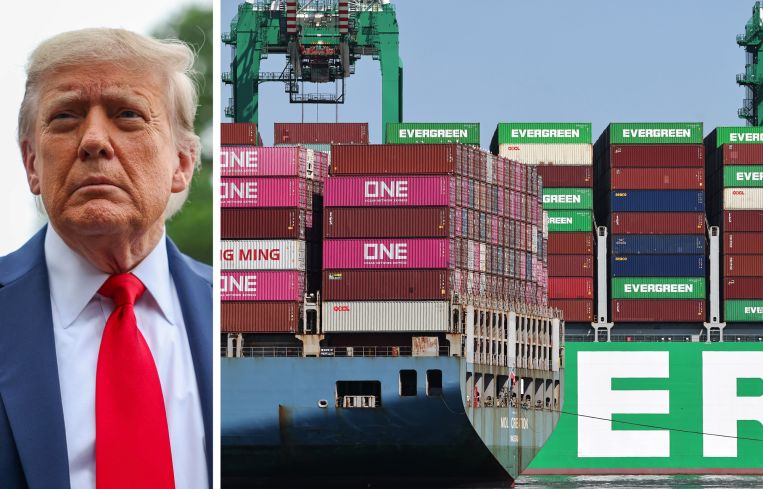Trump Tariffs Erode Inland Empire’s Industrial Machine Despite Solid Fundamentals
Rents have dropped every quarter for the past two years, though leasing activity and employment are trending in the right direction
By Nick Trombola July 17, 2025 6:45 pm
reprints
The nation’s largest warehousing market is experiencing a complex web of mixed performance, as it juggles solid fundamentals with uncertain economic conditions and volatile trade policy.
The industrial sector in California’s Inland Empire — the vast region east of Los Angeles that includes Riverside and San Bernardino counties — saw a slight uptick in vacancy and availability rates in the second quarter of 2025, continuing its trend of elevated rates since the beginning of 2023, along with negative net absorption and declining rent prices for the eighth consecutive quarter, according to CBRE’s latest quarterly report.
Yet, strong leasing activity, an increase in build-to-suit developments and the region’s proximity to the biggest ports in the Western Hemisphere indicate that attention on Southern California is not going anywhere anytime soon.
Overall vacancy in the region modestly increased by 10 basis quarter-over-quarter to 6.7 percent, per CBRE. Availability jumped by 50 basis points to 10.5 percent quarter-over-quarter, even though sublease availability dipped to 15.6 million square feet compared with 16 million square feet in the first quarter of this year.
Net absorption rapidly swung back to the negative side with 740,000 square feet opening up this past quarter, compared with 3.6 million square feet of positive absorption the previous quarter. However, the negative turn was driven entirely by move-outs in large spaces of 500,000 square feet or more, according to CBRE, while building sizes below 500,000 square feet all experience positive absorption amid the tariff-induced rush on midsize warehouses.
Asking rates also continue to take a hit as landlords offer lower rents and tenant concessions as they compete to fill space. Average taking lease rates declined for the eighth straight quarter, dropping to $1.07 per square foot, per month. That’s a fall of 4.5 percent quarter-over-quarter and 15.7 percent year-over-year.
Sublease activity, which made up 15 percent of all leasing activity in the second quarter, has done its part to drive down rents. Sublease rents were 17.2 percent lower than new lease rents at 90 cents per square foot, per month, according to CBRE.
Yet not all the news coming out of the Inland Empire is pessimistic. Leasing activity stayed robust this past quarter (even if it lagged behind the first quarter of this year) at 10.7 million square feet, particularly with developments that range from 250,000 to 499,999 square feet.
Similarly, Prologis — the nation’s biggest warehousing landlord and developer — reported a record leasing pipeline. But the REIT’s outgoing CEO Hamid Moghadam said it’s been difficult operating under “a condition of constant uncertainty,” with more tenants putting new deals on hold until the tariff dust settles.
Development projects also saw an uptick compared to the first quarter, with 5.5 million square feet breaking ground, the vast majority of the projects in the largest size range. Three massive new build-to-suit projects led the charge, the largest of which will top out at 2.6 million square feet.
The three largest lease deals in the second quarter all surpassed 700,000 square feet, though two of the three were renewals. The largest was a roughly 1 million-square-foot deal (from an undisclosed tenant) at EQT’s Hesperia Commerce Center One, followed by Burlington’s 758,180-square-foot renewal in San Bernardino and American Beauty Supply’s 715,433-square-foot renewal in Rialto.
Sales activity was more of a mixed bag. The amount of sales across the Inland Empire more than doubled compared with the beginning of 2025, though the volume of space that traded hands — at 456,000 square feet — dropped by 43 percent quarter-over-quarter, and 58.7 percent year-over-year. Tariff uncertainty, along with continually declining rent growth, drove some investors to hold off on acquiring new space, according to CBRE.
The sheer volatility of President Donald Trump’s trade policies is causing much of the activity anxiety in the Inland Empire, as the Ports of Los Angeles and Long Beach feed directly into many warehouse and logistics operations in the Inland Empire. Activity in the ports themselves has been variable as well. As importers rushed to avoid tariffs, the Port of L.A. reported the busiest June throughout the port’s 117-year history.
Still, hard economic data indicates that the Inland Empire is still in a good spot overall, per CBRE. Unemployment in the Inland Empire fell to 4.8 percent in the second quarter of this year, whereas overall unemployment in California remained steady at 5.3 percent, while the rate of inflation has continued to trend downward since 2022 and consumer activity remains robust. Indeed, CBRE actually increased its GDP growth projections to 1.3 percent for 2025.
Nick Trombola can be reached at ntrombola@commercialobserver.com.



